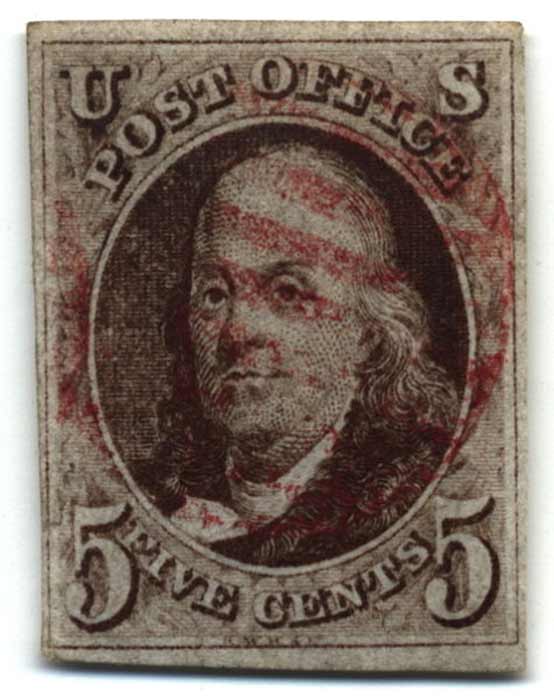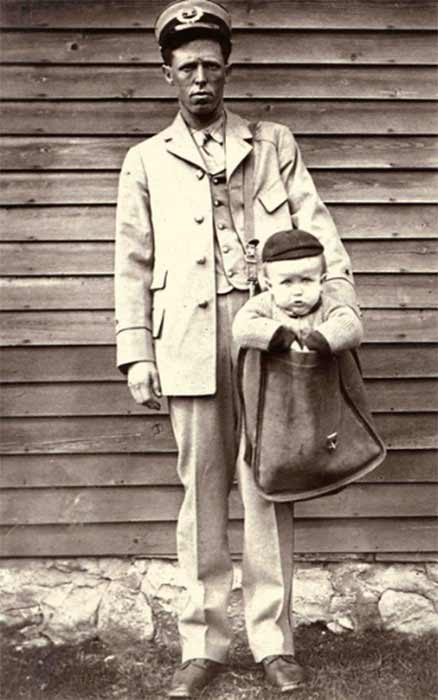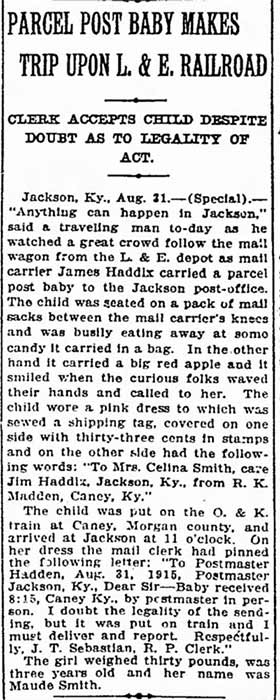The idea of sending babies through the mail seems incredible, if not outright unbelievable. And certainly this is one of the strangest phenomena to strike America in the early 20th century. But between 1913 and 1920, the creation and cultivation of the parcel post service allowed a few savvy parents to mail their children across the country, albeit dependent on weight.
Prior to the parcel post service, Americans would have to take their goods to a nearby town that operated with a private delivery company. These were often expensive and operated within their own rules, which led to many people feeling short changed. The Parcel Post Service on the other hand had a set price for delivery, offered up to the weight of 50lbs (22.5kg).

This led to strange goods showing up all around America in the mail. Coffins, entire banks and houses, and eventually even children all began to appear. There were no provisions in the parcel post regulations to prevent sending humans through the mail at that time. Parents started to realize this and send their children to relatives in the care of the local mail carrier. It was cheaper than buying a train ticket!
Thankfully, this did not result in children being stuffed into mail bags and covered in stamps alongside other packages. Children were supervised by the mail carriers. There was a huge level of trust between the local mail carriers and the community. But how did this all come about?
The Postal Service
On July 26th 1775, The US postal system was created by the Second Continental Congress, with Benjamin Franklin, a founding father of the US, as the postmaster general. Armed with this charter, he created the foundation of today’s mail system.

Franklin made the postal system efficient and standardized costs based on distance and weight. It became a crucial part in spreading support for the fledgling democracy that was flourishing in the US.
By the 1840s, the post was in crisis, however. High prices led to citizens looking to source cheaper methods of post. Private companies set up offering the same service for less money, effectively cutting out the Post Office.
- Terrifying Letters: The Watcher House of Westfield, NJ
- Why Did The Chinese Blast Tunnels in the Sierra Nevada?
Congress responded to this by making the US postal service a public service that no longer had to make a profit. As well as revitalizing the postal service, this had other hidden benefits. For example, the post was able to subsidize transportation infrastructure allowing for the spread of the railways.
Finally, by the end of the 19th century, the Rural Free Delivery and the Parcel Post services were created to allow rural residents to take part in the service. Everywhere from the east coast to the west coast of America was connected.
Mailing Babies
In 1913, Ohio saw the first ever recorded example of a baby sent in the mail. Jesse and Mathilda Beagle wanted to send their 10lb infant son to his grandmother in Batavia, a mile away. Unfortunately, money was tight, and they could not afford a train ticket.
So he went by mail. It cost them only 15 cents to mail him to his grandmother under the care of the local mail deliverer. Unsurprisingly, this story soon made the headlines and before long similar stories began to emerge across America about babies being mailed.
Only months later the Savis family of Pine Hollow in Pennsylvania paid 45 cents (approximately $11 today) to mail their daughter to relatives in Clay Hollow, a journey that could take hours to complete. And they were not the first to see the cost-effective benefits of this system.

The most famous mailed child is known to have been five-year-old Charlotte May Pierstorff who wanted to visit her grandmother. Sadly, her grandmother lived in Grangeville Idaho and it was too expensive to visit, the journey costing $1.55 or $37.90 in today’s money. Instead, they spent a third of the money and mailed her.
Charlotte was not left in the care of a complete stranger. She was accompanied by her mother’s cousin, who worked as a clerk for the railway services. This is most likely why the ‘mailing’ was allowed to proceed in this instance.
- 4 Famous Mysteries in United States History
- 100-Year-Old Secrets – What was Hidden in the Michigan Station Beer Bottle?
His willingness to chaperone the whole affair ensured that no problems were encountered on this grand journey. This episode became so famous that it has made into a children’s book called ‘Mailing May’.
Most journeys tended to be down the road but there are still notable examples of larger trips completed throughout this period. One of the largest was from Kentucky to Jackson, Mississippi. The postal service continually strove to put a stop to it.
The End Of Babies In The Mail
Joseph Stewart, the Second Assistant Postmaster General, attempted to curb this behavior in 1914 when he announced that children and humans should no longer be sent through the mail. Despite this, only a month after Stewart’s announcement, a rural carrier called BH Knepper transported a child 12 miles so that a grandparent could return the child to its parents.

Gradually though, the postmasters put a stop to the practice, and the journey from Kentucky to Jackson in 1915 is one of the last recorded examples of a baby travelling by mail. Even this is uncertain, as the practice was so unusual by this point that it led to an investigation.
However, it seems that this did not stop people trying. In June 1920, the First Assistant Postmaster General, John C Koons, received two applications to mail children. The applications tried to get around the embargo by claiming that the children were harmless live animals.
Koons rejected this outright, leading to a headline in the Washington Herald stating: “Can’t Mail Kiddies: Dangerous Animals.” The Postal Service still to this day has regulations that allow some live animals to be posted, but maintains a strict “no babies” policy.
A Quirk Of American History
It is a strange and odd part of American history that for some seven years, people sought to mail babies across the country. However, it does show fascinating insights into early 20th century America, and the clear sense of community and trust in rural communities at this time.
However it has more ominous foreshadowing as well. If someone at the time had asked why families were resorting to sending their children by mail, they might have seen the rising costs caused by inflation and other bad economic indicators at the time. The country was heading for a crash, if only they had the wit to see it.
Top Image: Postal babies. Source unknown
By Kurt Readman